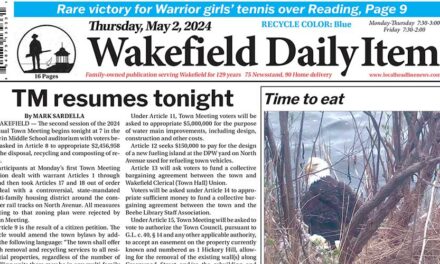Published in the December 7, 2016 edition

THE DAY AFTER the attacks on Pearl Harbor, the Daily Item was seeking information about any local residents serving in Hawaii at the time the naval installation was bombed and torpedoed by the Japanese.
WAKEFIELD — The country was shaken to its core 75 years ago today when the naval installation at Pearl Harbor, Hawaii, was attacked by the Japanese.
America was pulled into World War II and by its end would be an undisputed global power.
Hundreds of Wakefield residents signed up for service in the days and weeks that would follow. Some were already in the military, among them those stationed in Hawaii.
Following is a Looking Backward account of those hours after the U.S. was attacked.
Sunday, Dec. 7 — The Japanese attacked Pearl Harbor this morning (Honolulu time) with both aircraft and small boats. The Japanese diplomats had to uncode the message they were to deliver to the U.S. government; by the time they went to U.S. officials to deliver the word that Japan was breaking off diplomatic relations, the attack had been going on for half an hour. The aircraft came in two waves, the first under Captain Mitsuo Fuchida, who gave the signal To, To, To (Fight) at 7:48 a.m. and shortly after Tora, Tora, Tora (Tiger). By 7:55 a.m. the attack was well underway. The two waves of Japanese aircraft saw 353 fighters, bombers and torpedo planes flying from six Japanese aircraft carriers (four would be sunk at Midway in the summer of 1942 in an American ambush after the Japanese code had been broken) hit all eight battleships in Pearl Harbor (the Arizona, where 1,177 of a crew of 1,400 were killed, is a permanent memorial to all those who died in the attack). Also still in Pearl Harbor is the pre-WWI dreadnaught Utah, a radio controlled target ship by 1931 (64 of her crew of 519 were killed). Of the other battleships, Nevada, a superdreadnaught three years newer than Utah, was the lone battleship to get underway during the attack but ended up beached near the Navy Yard (about 50 were killed and 109 wounded out of nearly 1,500 crew) as it sunk in shallow water; it was refloated Feb. 12, repaired and went back in service. West Virginia had 66 men trapped when the ship sank, three of them in a storeroom with food and fresh water; later a calendar showed one or more were alive until Dec. 23. The California was sunk with the loss of 100 of its 1,083 crew, but was refloated March 25, 1942, repaired and put back in service. The Oklahoma lost 429 of its crew of 1,398 and had everything of value stripped from her before her hull was sold in 1946; about 500 miles east of Hawaii as it was being towed to the West Coast the hulk went down gently in the Pacific. The pilots concentrated on the battleships but sank smaller ships and damaged three cruisers, Honolulu, Raleigh and Helena, three destroyers, including Monaghan, and three other vessels, including the minelayer Oglala, the tug Sotoyomo, and the repair ship Vestal, all of which were eventually refloated and repaired. The raiders destroyed 188 aircraft, wiping out those on Hickam Field and Wheeler Field and 33 of the 49 planes at Ewa and damaged 159 more planes. Including some civilians, the Japanese sneak attack killed 2,402 and wounded 1,178. The Japanese lost four midget submarines (a fifth was grounded) and 29 aircraft, some by accident as they tried to land on their carrier. The task force had 64 killed and the captain of a midget submarine captured.
The first wave had 183 planes in it, but the second, which left the carriers at 7:15 a.m., arrived at 8:40 a.m. with 134 bombers escorted by 36 of the famed Zero fighters. The Americans now have their anti-aircraft guns working but by 9:06 a.m. the attack centered on the battleship Pennsylvania and the destroyers Cassin, Downes and Shaw, the latter in drydock. By 9:45 a.m. the second wave is back to the carriers and Mitsuo Fuchida wants to continue looking for the carriers that were not at Pearl Harbor and their escort but Admiral Nagumo is content with the results and needs to reach his refueling tankers to the north. By Dec. 23 all of the Japanese fleet is back at Hashirajima roadstead.
Other Attacks — Japanese aircraft destroyed eight of the dozen American planes on Wake Island. In the evening two destroyers shelled the airfield on Midway Island.




